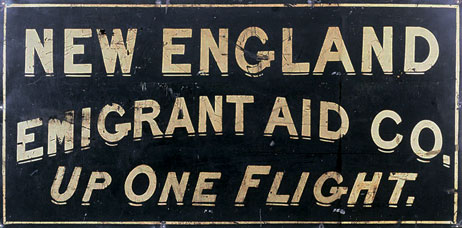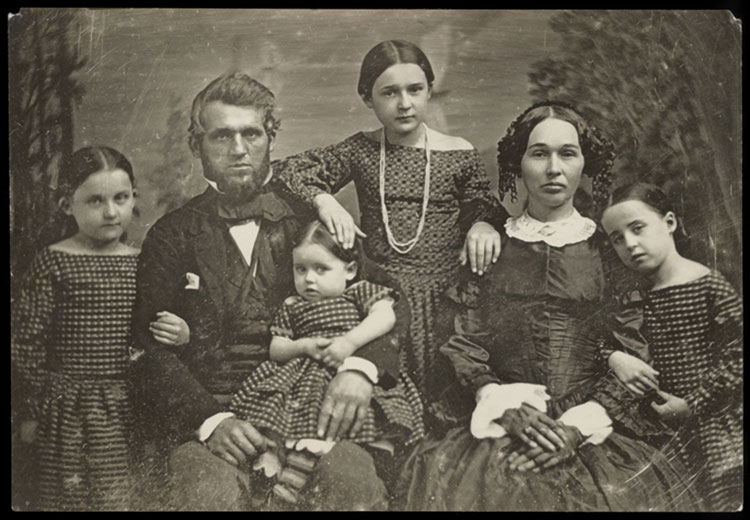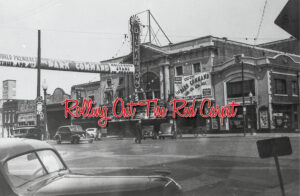The Makeup of Early Kansas Settlers
| 2018 Q1 | story by Patricia A. Michaelis, Ph.D., Historical Research & Archival Consulting | photos from the Kansas State Historical Society, KansasMemory.org

New England Emigrant Aid Co. – sign
How do you create a town on a frontier? The founding of Lawrence was the result of the efforts of a for- profit company: the New England Emigrant Aid Company (NEEAC). Organized in 1854 as the Massachusetts Emigrant Aid Company, its purpose was to disseminate information to encourage settlement in Kansas Territory; to assist emigrants from the east by organizing parties to be “conducted” to Kansas by agents of the company who had negotiated discounts on rail and steamboat fares; and to invest the capital that was raised by selling stock in building mills, hotels and other local improvements. One document from the company anticipated bringing 20,000 settlers to Kansas. Underlying the effort to bring emigrants west was the belief that Kansas should enter the Union as a free state.
These overly ambitious goals were only partially met. The company recruited only about 1200 settlers to Kansas Territory. About 450 people in five parties came to Kansas under the auspices of the company in 1854. Another 800 emigrants traveled in seven parties in 1855. Lists of the members of these various parties were published in the Kansas Historical Quarterly, in the May and August issues of 1943. In addition, the NEEAC did not make a profit for its investors, with much of its capital coming from Amos Lawrence, hence the name “Lawrence” for the company’s most successful city. Mr. Lawrence said that no one should invest more than they could afford to lose, illustrating his belief that the company would not make a profit. Lawrence was a key figure in the United States abolition movement in the years leading up to the Civil War. He contributed funds for the Sharp rifles, called Beecher’s Bibles, which were shipped to Kansas to support the free state cause.
What kind of occupations did settlers need to create a new town? You need farmers to grow food, and number of them were members of the various parties. The opportunity to own land was very attractive to these emigrants because the oldest son inherited the family farm in New England, and the high price of land was out of reach for other sons in a family. New towns also needed carpenters to build houses and other structures, someone to run a sawmill to produce lumber, perhaps a doctor and probably a merchant to sell various supplies among others. The first three parties (out of a total of six), the human resources, came to Kansas under the auspices of New England Emigrant Aid Company in 1854.
The first party left Boston on July 17, 1854, and arrived in Kansas City on July 29. The group organized in Worcester, Massachusetts, and traveled by train to Buffalo, New York, followed by a steamboat trip to Detroit, Michigan. The party then took a train to St. Louis and proceeded to Kansas City on the Missouri River via the steamboat Polar Star. Charles Robinson, an agent for the NEEAC and later the first governor of Kansas, met the group in St. Louis, and another agent for the company, Charles Branscomb, joined the party in Kansas City. The party then traveled to a location on the Wakarusa River, the site of present day Lawrence.

Portrait of Shalor W. Eldridge, his wife, and their four daughters was taken November, 1854 in Westfield, Massachusetts. Eldridge was involved with the New England Emigrant Aid Company and operated a company hotel in Lawrence, Kansas Territory.
This party consisted of 29 men from various parts of New England. The occupations of those remaining included three farmers, two physicians, two mechanics, as well as a banker, carpenter, architect, clerk, merchant, reporter, sportsman and clergyman/speculator. One of the physicians in the first party was John Doy, who was imprisoned by Missourians for helping slaves escape in 1856 but was later rescued by free state supporters. Ferdinand Fuller, the architect, designed North College, the first building on the University of Kansas campus and many other Lawrence structures, including the Free State Hotel that was burned during the sack of Lawrence, Central School and his home at 1005 Sunset Dr.
The second party left Boston on Aug. 29, 1854 and arrived in Kansas City on Sept. 6. This party had 67 members, including several wives and children. One woman, Susan Bassett, came with her son Owen. Most of the members of this party were from Massachusetts. Others were from Michigan, New York, Ohio, Vermont and Wisconsin. Twenty-one farmers were part of this group, as growing produce and various crops was needed to support the town. Other professions represented in the group were carpenters, merchants, lawyers, engineers, shoemakers, machinists, a blacksmith, painters, physicians and a cabinetmaker. An important member of the second party, as least for promoting an orderly settlement, was Albert Dwight Searl, from Brookfield, Massachusetts. He was a civil engineer and produced the first city survey for Lawrence, including laying out Massachusetts Avenue. Samuel Clarke Pomeroy, from Southampton, Massachusetts, was a lawyer and served as a financial agent for Emigrant Aid Company. He later settled in Atchison and represented Kansas as a U.S. senator from 1861 through 1873. James Emery, a member of the second party, participated in the Topeka and Leavenworth constitutional conventions and, later, was appointed U.S. District Attorney (1863-1867) by Abraham Lincoln.
Erastus D. Ladd, from Milwaukee, Wisconsin, was a member of the second NEEAC party, described Lawrence in a letter written Sept. 19, 1854. He wrote:
All here are still living in tents, and it would please you to see us men at the hour of meals, gathered around our camp fires with our frying pans, tea kettles, bake kettles and other appliances, providing our food, some to the wrists in dough, preparing bread, and others washing dishes. Well, this will be obviated when we get places to live, and our wives and families (those who have them, the rest of us can board or keep bachelor’s hall,) come on.
We have just finished a large house that will be opened on Monday next as a boarding house; board for members is $2.50 per week. It is constructed of poles, the roof thatched prairie grass, and the sides and ends covered with cotton cloth. We are constructing another similar to it for the occupation of the pioneer party, as they must surrender their tents on the arrival of the large party which is to leave Boston on the 26th inst.
Ladd’s description paints a mental picture of life in Lawrence after the arrival of the second party of Sept. 26, 1854. He served as postmaster in 1855.
The third party of 1854 left Boston on Sept. 16 and arrived in Kansas City on Oct. 7. As before, the transportation was a combination of rail, steamboat and wagon. The group consisted of men, women and children from Connecticut, Massachusetts, New Hampshire, New York, Pennsylvania and Vermont. They were joined by the Rev. Samuel Adair, with the American Missionary Association, his wife and son, from Ohio, and a farmer from Indiana.
A variety of occupations were represented in the party, with farmers being the most numerous at 39. It also included 11 shoemakers, 10 carpenters, nine laborers, four blacksmiths, four machinists, three bootmakers, three tanners and two manufacturers. Other occupations represented were a toolmaker, merchant, clerk trader, wheelwright, butcher, currier, millwright, bookkeeper, painter, mason, teacher, carriage maker, daguerreotyper (photographer) and a physician. Three members of this group were killed in Quantrill’s raid. One unusual notation was for a farmer named James B. Wheeler. It said, “Confirmed drunkard, sent back from Detroit.”
It doesn’t take great imagination to understand the difficulty of travel west with families and household goods, switching forms of transportation several times and arriving in a location that had few permanent structures. While the aid company provided conductors for the parties, things did not go smoothly. A correspondent for The New York Times who traveled with the third party provided the following report on Oct. 9, 1854:
The truth is, that the Boston Emigrant Aid Company has by no means fulfilled its pledges to the public or its duty to its proteges. There seems a total lack of system in their operations, of efficiency in their agents. The last company, which arrived early Saturday morning, in charge of Mr. Brunscombe, are loud in the complaints and justly so. They were about ten days on the road, subjected to much greater expense than had been expected, frequently scattered, both members and baggage being left behind at several points on the way, and worse than all, finding on their arrival not the least provision made for their comfort, or to facilitate their location. The Company advertises at home, to provide good board, till the emigrants locate at a dollar and a half per week; while the truth is that the only accommodation is found at a professed hotel owned by them, and kept in the most shameful manner, as regards cleanliness and fare, at the rate of a dollar and a quarter a day.
The reporter’s tirade continued for several more lines. As this account indicates, the efforts of the New England Emigrant Aid Company were not successful in preparing for the arrival of settlers or providing support for them once they arrived. It was responsible for slightly more than 1,200 settlers in 1854 and 1855. Some of the people associated with the company had an impact on the history of Kansas, including Charles Robinson, the first governor of the state of Kansas; Samuel Clarke Pomeroy, U.S. senator; and Albert Searl, the surveyor who laid out Lawrence, Topeka and many other Kansas towns. Many of the men in the aid company parties served in Kansas units during the Civil War. The contributions of women were in establishing homes and raising the first generation of Kansans. One important goal of the company was met: making Kansas a free state.




4 Comments
Hey, thanks for the article post.Thanks Again. Want more.
This is one awesome post.Thanks Again. Much obliged.
Im thankful for the article.Really thank you! Will read on…
I value the post. Great.